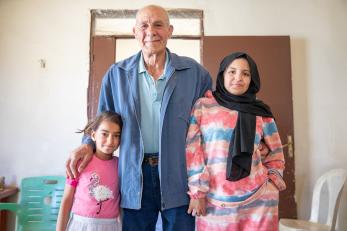Livelihood Outcomes of Multi-purpose Cash Assistance

Since 2019, the severe economic crisis in Lebanon has plunged a large portion of the population into poverty. Over the last decade, poverty has more than tripled, reaching 44% in 2022. Many families were forced to adopt negative coping strategies such as reducing food consumption and withdrawing children from school due to inadequate government support. To alleviate the socio-economic vulnerability of poor Lebanese families, Mercy Corps implemented the "Services and Assistance for Enabling Recovery" (SAFER) programme from December 2022 to February 2024. Under the SAFER programme, Mercy Corps distributed multi-purpose cash assistance (MPCA) transfers of USD 150 per household per month to 1,251 vulnerable families in the Bekaa region, along with financial management and coaching for 350 participants.
The SAFER programme improved food security and reduced poverty among participants but fell short of providing sustainable pathways to maintain families out of poverty. During the programme duration, employment rates declined due to factors like underemployment and business closures. This evaluation aimed to assess the impact of SAFER assistance on promoting livelihood pathways, identify family profiles likely to achieve self-reliance, understand factors affecting livelihood opportunities, explore the role of MPCA and financial training, and identify complementary activities for future phases.
Using a predominantly qualitative approach supplemented by secondary data, the study collected primary data through in-depth interviews with participants and key informants. It focused on capturing participants' perspectives, identifying factors that empowered or hindered their journey to self-sufficiency, and defining secure livelihoods.
Main Findings
Findings showed that unemployment among SAFER participants was often due to old age, disability, or chronic illnesses, with 63% of those over 50 citing these reasons. Secondary data corroborated that 35% of non-working individuals were of retirement age, with unemployment increasing with age. Health issues, retirement, or inability to find work were the main reasons for job loss in the past three years.
Working participants were mostly self-employed in unstable jobs without social protection benefits, and very few reported leaving their jobs voluntarily due to extremely low salaries. Working women faced conflicts between jobs and childcare, preferring flexible or home-based work. A wide social network and referrals were crucial for job maintenance, although jobs remained unstable.
Families with senior members and fewer children tend to deprioritise basic needs and accept poor living conditions, while larger families with young children face high expenses, compelling heads of households to maintain or seek employment despite inadequate wages and unfavorable working hours.
There is no evidence that the SAFER MPCA programme led participants to quit employment or increased dependency on assistance. Those who lost jobs did not correlate this with MPCA, and job seekers continued their search while receiving assistance, as it was insufficient to cover all needs. Employed participants reported that MPCA helped repay debts and cover expenses without encouraging them to quit their jobs.
In summary, MPCA stabilised finances and facilitated job transitions without causing participants to quit existing employment. The study identified pathways through which MPCA, and financial training stimulated positive livelihood opportunities, such as direct investment in self-employment and career changes. Participants who effectively used MPCA typically had established businesses or experience in home-based income generation and were of working age without debilitating health conditions.
Recommendations
Successful graduation strategies should address multiple poverty-trapping factors and offer tailored support, including combining MPCA with healthcare, education, and cash-for-work programmes. A multifaceted graduation approach targeting basic needs, income generation, social empowerment, and financial support is recommended. Lasting impact also requires reforms to Lebanon's social security system (NSSF) alongside cash assistance programmes.
More generally, cash assistance should be conceptualised within a larger market-system development (MSD) approach that considers the “push” and “pull” factors. SAFER provides push factors in the form of MPCA and financial literacy training. The pull factors correspond to the private sector-led market access support. In practice, this requires coordination between cash assistance programmes (like SAFER) and the various Mercy Corps interventions in the various regions of Lebanon, which do follow an MSD approach.
On a more micro level, mentoring and training is essential for low skilled and seasonal employees to be able to better integrate into the job market. Therefore, all cash recipients who are categorised as able to work could also be part of a training programme that corresponds to their skillset / economic activity sector. For women heads of household, balancing childcare and employment posed a major challenge; therefore, providing adequate childcare facilities or supporting home based economic activity should be explored.


